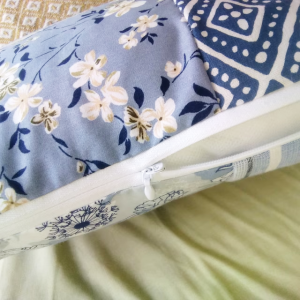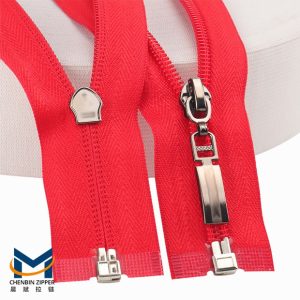
Exploring the Basics of Nylon Reverse Zippers and Traditional Zippers
Composition and Structure
Materials Used in Manufacturing
There are multiple types of nylon reverse zippers and classic zippers that are made of different materials. Nylon reverse zippers, as its name implies, actually work using nylon yarns, monofilaments and sewing threads as its primary constituents. This combination provides versatility but also a foundation where it feels good and rocks well smoothly. Traditional zippers are created from metal, plastic or nylon. The material chosen influences the weight of the zipper, durability of the zipper and whether or not it is suitable for a particular application.
Design Differences
Nylon reverse zippers and other traditional zippers have a fair bit of difference in the design. The difference with nylon reverse zippers is the zip coils are inside the tape. This gives it a nice outer skin that looks good and protects the zipper teeth more than plastic do. In conventional zippers, the teeth are exposed, and they come in various sizes and shapes depending upon their application.
Mechanism of Operation
Functionality of Nylon Reverse Zippers
Nylon reverse construction zippers hide the coil inside the fabric tape. This design increases not just look but additionally has higher interaction with fabric or skin. This hidden coil can provide more resistance against wear and tear when compared to traditional coils that remain out in the open. A hidden coil can be better protected against use than an exposed coil.
Functionality of Traditional Zippers
Traditional zippers function with exposed teeth that interlock when zipped up. They are often used in applications where robustness is required, such as in heavy-duty clothing or luggage. The straightforward mechanism makes them reliable for frequent use.
Evaluating Durability and Longevity
Wear and Tear Resistance
Environmental Factors Impacting Durability
Since nylon zippers are synthetic, it tends to be quite resistant to outside factors like humidity and high/low temperatures. Because of this, they are excellent for outdoor applications. Metal zippers can corrode if not cared for properly and plastic types can break down when exposed to UV.
Usage Scenarios and Lifespan
Nylon reverse zippers usually have a long lifespan because of the durable materials used combined with a design that protects the teeth from dirt and grime, which wear and tear most fasteners. You can use them frequently in products such as jackets or bags. Metal zippers are durable but require maintenance to deter rust, whereas plastic ones are less robust but corrosion-free, making their lifespan highly dependent on material, within the pre-requisite confines of a traditional zipper.
Maintenance Requirements
Cleaning and Care Techniques
Reverse zippers that are nylon need very little care because of the protective nature. A few of them prefer to work with a bit of mild soap and water regular cleaning. If you have a traditional metal zipper you will have to take extra care to prevent the zipper rusting, applying a graphite or silicone-based lubricant as needed. Keep metal zippers lubricated with graphite or other silicone-based products to avoid rust; they require more care.
Repairability and Replacement
While Nylon reverse zippers rarely need repair because of how tough they are, they are often hidden and can be difficult to fix if they do break. Zippers that close with interlocking teeth are often simpler to fix or replace, too, since the individual teeth can be reached more easily. Individual teeth are harder to repair or replace on a zero-force zipper.
Assessing Versatility and Applications
Industry Usage and Preferences
Fashion Industry Implementation
Nylon reverse zippers are widely used in fashion because they disappear in a garment and do not interrupt design lines resulting in a clean look. They are used typically in women dresses where an invisible closure is needed. Conventional zippers still seem to be the favorite option in terms of strength, where we tend to use in jeans or jackets. In jeans or jackets, traditional zippers are still a strong player due to their robustness.
Outdoor Gear and Equipment Applications
Nylon reverse zippers are recommended for outdoor gear such as tents or backpacks due to their high resistance to environmental wear and high performance on load. Where function trumps form, traditional metal or plastic zippers are still in use. Old metal or plastic zippers are possibly be used where strength is more important than beauty.
Aesthetic Considerations
Visual Appeal in Design
Nylon reverse zippers provide a clean look by hiding the coil inside the tape, making them ideal for designs requiring subtle closures like cushions or pillowcases. The absence of visible teeth enhances garment elegance.
Customization Options
Both have high sample availability and customization for not only size but color, material (nylon, metal), tooth shape, waterproofing options, invisibility options, branding opportunities . Wide range of customization options including size, color, material type (nylon, metal), tooth shapes, waterproofing, invisibility, and branding.
| Feature | Nylon Reverse Zipper | Traditional Zipper |
| Material | Nylon yarns/monofilament | Metal/Plastic/Nylon |
| Coil Position | Inside (concealed) | Outside (exposed) |
| Durability | High resistance to elements | Varies by material |
| Aesthetic | Seamless integration | Visible teeth |
| Maintenance | Minimal care needed | Requires regular upkeep |
This detailed analysis illustrates how nylon reverse zippers stand out in terms of aesthetics and durability while traditional options offer robustness across various applications.
Analyzing Cost-Effectiveness
Production Costs Comparison
Economic Implications for Manufacturers
Due to the different materials and manufacturing processes, the production costs of nylon reverse zippers and ordinary zippers are significantly different. Nylon reverse zippers, which are mainly used by nylon yarns and also monofilaments, gain advantage from positive economic of synthetic materials. This may bring down the cost of manufacturing and since, manufacturers buy these materials in bulk, the quality will be consistent and supply will be regular. As they often require a higher cost of production due to the high cost of raw metal materials and the fact that they are silver are always a complex process for the manufacturing of a traditional zipper.
Consumer Pricing Trends
Consumers see these differentials in production costs reflected in price trends as well. Consumers seeking durability and looks from a reverse zipper often go with nylon due to historically lower manufacturing costs leading directly into lower costs to the consumer as well. While metal traditional zippers may be more expensive due to their strength and higher material costs, in most other cases, plastic zippers are actually considerably cheaper.
Value for Money Assessment
Performance Versus Price Ratio
True, if you compare performance versus price, nylon reverse zippers make a good case. They are well designed to stay hidden from the view of your eyes and look stylish while giving you the best resistance from wear and cost worthy with better performance. Classic zippers come with a solid locking system, but the value varies with the material.
Long-Term Investment Benefits
Nylon reverse zippers offer noticeable advantages for long-term investments due to their long lifespan and minimal maintenance costs. They can withstand environmental influences, which makes them durable support surfaces like in an outdoor or fashion piece. On the other hand, traditional zippers can need to be serviced or replaced more often, which can rack up long-term costs. The durability of a zipper can translate into cost savings in the long run, but traditional zippers may involve more frequent maintenance or replacement.
Examining User Experience and Feedback
Ease of Use and Convenience
User-Friendly Features
Nylon reverse zippers feature some of the most user-friendly elements that make them easy to use. The glossy outer surface minimizes the drag against clothing or skin for easy operation even under duress. This makes them recommended for applications that necessitate frequent opening and closing. These lend themselves to applications where open and close are constant.
Consumer Satisfaction Levels
Reviews from Industry Experts
Many industry experts praise nylon reverse zippers because they can be practically sewn into garments and upholstery projects where an invisible closure is desired. Professional reviews emphasize how they can seamlessly integrate with fabrics without disrupting design lines. According to user reviews, their ability to seamlessly blend with materials without breaking up design lines is a key plus point.
Over the rest of this comparison we will show how and why not only do nylon reverse zippers offer more to consumers in the way of quality and user experience at a cost effective price, but that traditional options will only continue to hold up in the most rigid of applications.
| Aspect | Nylon Reverse Zipper | Traditional Zipper |
| Production Cost | Lower (synthetic materials) | Higher (metal/plastic) |
| Consumer Price | Competitive | Variable (material-dependent) |
| Performance/Price Ratio | High (durable/aesthetic) | Varies (material-specific) |
| Long-Term Benefits | Durable/low maintenance | Potentially higher upkeep |
| User Experience | Smooth/easy operation | Robust/simple mechanism |
| Satisfaction Level | High (aesthetics/durability) | Mixed (style/functionality) |












